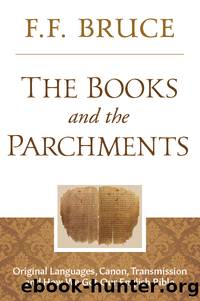The Books and the Parchments by F.F. Bruce

Author:F.F. Bruce [Bruce, F.F.]
Language: eng
Format: epub
Publisher: BookBaby
Published: 2018-03-22T17:00:00+00:00
* * *
232 It can now be revealed (as they say) that the first speaker was Dr. D. Martyn Lloyd-Jones; the second was Dr. William J. Martin of Liverpool University. The conference, held in 1941 at Kingham Hill, Oxfordshire, is mentioned in my In Retrospect, p. 122.
233 Later writers improved on this account by telling how the 72 translators did their work in separate cells, and how after 72 days, all their versions were found to coincide exactlyâsufficient proof of the divine inspiration of the work!
234 Note that primarily the term âSeptuagintâ applies to the Pentateuch only; it was at the time of Origen (early 3rd century A.D.) that it came to denote, as it does now, the whole Old Testament in Greek.
235 See pp. 44 ff. Compare the Jews of Pathros (i.e. Upper Egypt) in Jeremiah 44:1, 15.
236 Cf. The Cairo Geniza, pp. 209 ff.
237 The opposite extreme, namely that the Greek Old Testament began absolutely with one fixed text, is maintained by the American scholar, Professor H. M. Orlinsky. See his brief introduction The Septuagint: The Oldest Translation of the Bible (Cincinnati, 1949).
238 One scholar who gave attention to this task in recent years was Dr. P. Katz (W. P. M. Walters) of Cambridge; cf. his Philoâs Bible (Cambridge, 1950), and âSeptuagintal Studies in the Mid-Centuryâ in The Background of the New Testament and its Eschatology, ed. W. D. Davies and D. Daube (Cambridge, 1956), pp. 176 ff. A distinguished pupil of Dr. Katz is Dr. D. W. Gooding; cf. his Recensions of the Septuagint Pentateuch (the Tyndale Old Testament Lecture for 1954), The Account of the Tabernacle: Translation and Textual Problems of the Greek Exodus (Cambridge, 1959), and Relics of Ancient Exegesis: A Study of the Miscellanies in 3 Reigns 2 (Cambridge, 1976).
239 See C. H. Roberts, Two Biblical Papyri in the John Rylands Library, Manchester (1936); Kahle, The Cairo Geniza, pp. 220 ff. This manuscript (p Ryl. 458) is of comparable date to the Cairo papyrus of the Greek Deuteronomy mentioned in note 175. Cf. W. G. Waddell, âThe Tetragrammaton in the LXX, â Journal of Theological Studies 45 (1944), pp. 158 ff.
240 This is not the only Jewish work which has been preserved by Christians. The same applies to the writings of Philo and Josephus.
241 See p. 160.
242 See p. 146.
243 The LXX version, quoted by James, spiritualized the original oracle; it presupposes Heb. yidrÄshu (âwill seekâ) for Masoretic yÄ«rÄshu (âwill possessâ), and âÄdÄm (âmanâ) for âEdÅm; and it neglects the particle âeth, the mark of the accusative case, which precedes shÄâÄrÄ«th (âremnantâ). But the LXX version may represent a variant Hebrew text which has disappeared; and even the Masoretic text would have served Jamesâs purpose (if not with the same explicitness), since it predicts that the house of David will regain its sovereignty over the Gentile nations formerly ruled by itâa prediction fulfilled and surpassed by the Gentilesâ yielding their allegiance to Christ as Lord.
244 Dialogue, chap. 73; cf. Justinâs First Apology, chap. 41. The phrase is not present in any copy of the LXX which has come down to us.
Download
This site does not store any files on its server. We only index and link to content provided by other sites. Please contact the content providers to delete copyright contents if any and email us, we'll remove relevant links or contents immediately.
Kathy Andrews Collection by Kathy Andrews(11765)
The remains of the day by Kazuo Ishiguro(8892)
Spare by Prince Harry The Duke of Sussex(5141)
Paper Towns by Green John(5138)
The Body: A Guide for Occupants by Bill Bryson(5030)
Industrial Automation from Scratch: A hands-on guide to using sensors, actuators, PLCs, HMIs, and SCADA to automate industrial processes by Olushola Akande(5025)
Machine Learning at Scale with H2O by Gregory Keys | David Whiting(4260)
Be in a Treehouse by Pete Nelson(3997)
Never by Ken Follett(3884)
Harry Potter and the Goblet Of Fire by J.K. Rowling(3808)
Goodbye Paradise(3761)
Into Thin Air by Jon Krakauer(3348)
The Remains of the Day by Kazuo Ishiguro(3347)
Fairy Tale by Stephen King(3307)
The Cellar by Natasha Preston(3298)
The Genius of Japanese Carpentry by Azby Brown(3254)
120 Days of Sodom by Marquis de Sade(3226)
The Man Who Died Twice by Richard Osman(3040)
Drawing Shortcuts: Developing Quick Drawing Skills Using Today's Technology by Leggitt Jim(3037)
